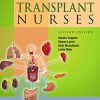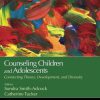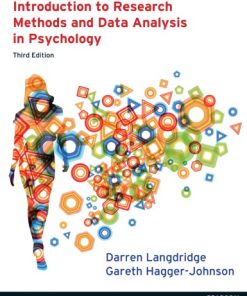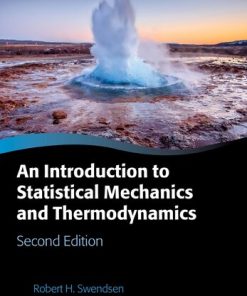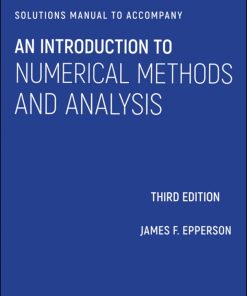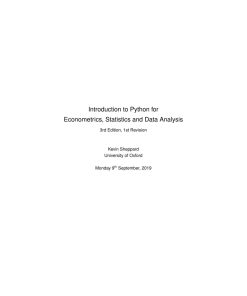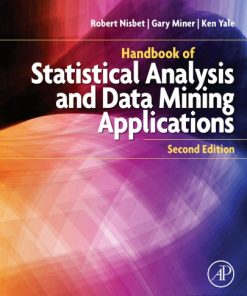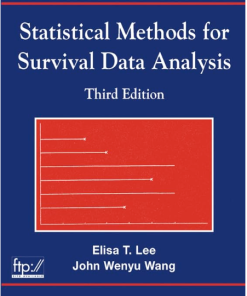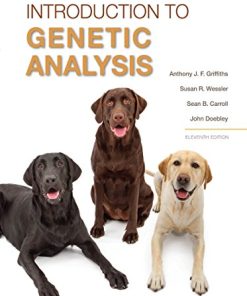An Introduction to Statistical Methods and Data Analysis 7th Edition, (Ebook PDF)
$50.00 Original price was: $50.00.$25.00Current price is: $25.00.
An Introduction to Statistical Methods and Data Analysis 7th Edition, (Ebook PDF) – Digital Instant Dowload.
An Introduction to Statistical Methods and Data Analysis 7th Edition, (Ebook PDF) – Digital Instant Dowload.
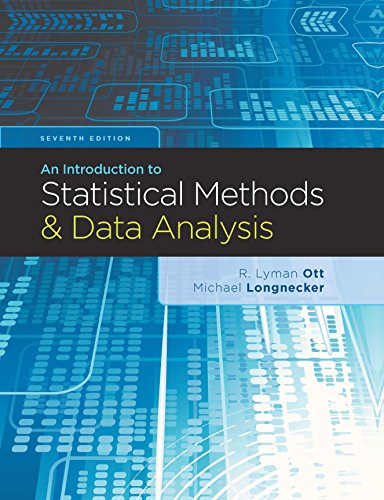
Product details:
- ISBN-10 : 1305269470
- ISBN-13 : 978-1305269477
- Author: R. Lyman Ott/Michael T. Longnecker
Ott and Longnecker’s AN INTRODUCTION TO STATISTICAL METHODS AND DATA ANALYSIS, Seventh Edition, provides a broad overview of statistical methods for advanced undergraduate and graduate students from a variety of disciplines who have little or no prior course work in statistics. The authors teach students to solve problems encountered in research projects, to make decisions based on data in general settings both within and beyond the university setting, and to become critical readers of statistical analyses in research papers and news reports. The first eleven chapters present material typically covered in an introductory statistics course, as well as case studies and examples that are often encountered in undergraduate capstone courses. The remaining chapters cover regression modeling and design of experiments.
Table contents:
PART 1: INTRODUCTION.
1. Statistics and the Scientific Method. Introduction. Why Study Statistics? Some Current Applications of Statistics. A Note to the Student. Summary. Exercises. PART
2: COLLECTING DATA.
2. Using Surveys and Scientific Studies to Collect Data. Introduction and Abstract of Research Study. Observational Studies. Sampling Designs for Surveys. Experimental Studies. Designs for Experimental Studies. Research Study: Exit Polls versus Election Results. Summary. Exercises. PART
3: SUMMARIZING DATA.
3. Data Description. Introduction and Abstract of Research Study. Calculators, Computers, and Software Systems. Describing Data on a Single Variable: Graphical Methods. Describing Data on a Single Variable: Measures of Central Tendency. Describing Data on a Single Variable: Measures of Variability. The Boxplot. Summarizing Data from More Than One Variable: Graphs and Correlation. Research Study: Controlling for Student Background in the Assessment of Teaching. Summary and Key Formulas. Exercises.
4. Probability And Probability Distributions. Introduction and Abstract of Research Study. Finding the Probability of an Event. Basic Event Relations and Probability Laws. Conditional Probability and Independence. Bayes’ Formula. Variables: Discrete and Continuous. Probability Distributions for Discrete Random Variables. Two Discrete Random Variables: The Binomial and the Poisson. Probability Distributions for Continuous Random Variables. A Continuous Probability Distribution: The Normal Distribution. Random Sampling. Sampling Distributions. Normal Approximation to the Binomial. Evaluating Whether or Not a Population Distribution Is Normal. Research Study: Inferences about Performance Enhancing Drugs among Athletes. Minitab Instructions. Summary and Key Formulas. Exercises. PART
4: ANALYZING DATA, INTERPRETING THE ANALYSES, AND COMMUNICATING RESULTS.
5. Inferences about Population Central Values. Introduction and Abstract of a Research Study. Estimation of ?. Choosing the Sample Size for Estimating ?. A Statistical Test for ?. Choosing the Sample Size for ?. The Level of Significance of a Statistical Test. Inferences about ? for a Normal Population, ? Unknown. Inferences about ? when Population in Nonnormal and n is small: Bootstrap Methods. Inferences about the Median. Research Study: Percent Calories from Fat. Summary and Key Formulas. Exercises.
6. Inferences Comparing Two Population Central Values. Introduction and Abstract of a Research Study. Inferences about ?1 ? ?2: Independent Samples. A Nonparametric Alternative: The Wilcoxon Rank Sum Test. Inferences about ?1 ? ?2: Paired Data. A Nonparametric Alternative: The Wilcoxon Signed-Rank Test. Choosing Sample Sizes for Inferences about ?1 ? ?2. Research Study: Effects of Oil Spill on Plant Growth. Summary. Exercises.
7. Inferences about Population Variances. Introduction and Abstract of a Research Study. Estimation and Tests for a Population Variance. Estimation and Tests for Comparing Two Population Variances. Tests for Comparing t > 2 Population Variances. Research Study: Evaluation of Methods for Detecting E. coli. Summary and Key Formulas. Exercises.
8. Inferences About More Than Two Population Central Values Introduction and Abstract of a Research Study. A Statistical Test About More Than Two Population Means: An Analysis of Variance. The Model for Observations in a Completely Randomized Design. Checking on the AOV Conditions. An Alternative Analysis: Transformations of the Data. A Nonparametric Alternative: The Kruskal-Wallis Test. Research Study: Effect on Timing on the Treatment of Port-Wine Stains with Lasers. Summary and Key Formulas. Exercises.
9. Multiple Comparisons. Introduction and Abstract of Research Study. Linear Contrasts. Which Error Rate Is Controlled? Fisher’s Least Significant Difference. Tukey’s W Procedure. Student-Neuman-Keuls Procedure. Dunnett’s Procedure: Comparison of Treatments to a Control. Scheffe’s S Method. A Nonparametric Multiple-Comparison Procedure. Research Study: Are Interviewers’ Decisions Affected by Different Handicap Types? Summary and Key Formulas. Exercises.
10. Categorical Data. Introduction and Abstract of Research Study. Inferences about a Population Proportion ?. Inferences about the Difference between Two Population Proportions, ?1 ? ?2. Inferences about Several Proportions: Chi-Square Goodness-of-Fit Test. Tests for Independence and Homogeneity. Measuring Strength of Relaxation. Odds and Odd Ratios. Combining Sets of 2 ? 2 Contingency Tables (optional). Research Study: Does Gender Bias Exist in the Selection of Students for Vocational Education? Summary and Key Formulas. Exercises. PART
5: ANALYZING DATA: REGRESSION METHODS AND MODEL BUILDING.
11. Linear Regression and Correlation. Introduction and Abstract of Research Study. Estimating Model Parameters. Inferences about Regression Parameters. Predicting New y Values Using Regression. Examining Lack of Fit in Linear Regression. The Inverse Regression Problem (Calibration). Correlation. Research Study: Two Methods for Detecting E. coli. Summary and Key Formulas. Exercises.
12. Multiple Regression and the General Linear Model. Introduction and Abstract of Research Study. The General Linear Model. Estimating Multiple Regression Coefficients. Inferences in Multiple Regression. Testing a Subset of Regression Coefficients. Forecasting Using Multiple Regression. Comparing the Slopes of Several Regression Lines. Logistic Regression. Some Multiple Regression Theory (Optional). Research Study: Designing an Electric Drill. Summary and Key Formulas. Exercises.
13. Further Regression Topics. Introduction and Abstract of Research Study. Selecting the Variables (Step 1). Formulating the Model (Step 2). Checking Model Assumptions (Step 3). Research Study: Construction Costs for Nuclear Power Plants. Summary and Key Formulas. Exercises. PART
6: DESIGN OF EXPERIMENTS AND ANALYSIS OF VARIANCE.
14. Analysis of Variance for Completely Randomized Designs. Introduction and Abstract of Research Study. Completely Randomized Design with Single Factor. Factorial Treatment Structure. Factorial Treatment Structures with an Unequal Number of Replications. Estimation of Treatment Differences and Comparisons of Treatment Means. Determining the Number of Replications. Research Study: Development of a Low-Fat Processed Meat. Summary and Key Formulas. Exercises.
15. Analysis of Variance for Blocked Designs. Introduction and Abstract of Research Study. Randomized Complete Block Design. Latin Square Design. Factorial Treatment Structure in a Randomized Complete Block Design. A Nonparametric Alternative�Friedman’s Test. Research Study: Control of Leatherjackets. Summary and Key Formulas. Exercises.
16. Analysis of Covariance. Introduction and Abstract of Research Study. A Completely Randomized Design with One Covariate. The Extrapolation Problem. Multiple Covariates and More Complicated Designs. Research Study: Evaluations of Cool-Season Grasses for Putting Greens. Summary. Exercises.
17. Analysis of Variance for Some Fixed-, Random-, and Mixed-Effects Models. Introduction and Abstract of Research Study. A One-Factor Experiment with Random Treatment Effects. Extensions of Random-Effects Models. Mixed-Effects Models. Rules for Obtaining Expecting Mean Squares. Nested Factors. Research Study: Factors Affecting Pressure Drops Across Expansion Joints . Summary. Exercises.
18. Split-Plot, Repeated Measures, and Crossover Designs. Introduction and Abstract of Research Study. Split-Plot Designs. Single-Factor Experiments with Repeated Measures on One of the Factors. Two-Factor Experiments with Repeated Measures on One of the Factors. Crossover Design. Research Study: Effects of Oil Spill on Plant Growth. Summary. Exercises.
19. Analysis of Variance for Some Unbalanced Designs. Introduction and Abstract of Research Study. A Randomized Block Design with One or More Missing Observations. A Latin Square Design with Missing Data. Balanced Incomplete Block (BIB) Designs. Research Study: Evaluation of the Consistency of Property Assessment. Summary and Key Formulas. Exercises. PART
7: COMMUNICATING AND DOCUMENTING THE RESULTS OF ANALYSES
20. Communicating and Documenting the Results of a Study or Experiment. Introduction. The Difficulty of Good Communication. Communication Hurdles: Graphical Distortions. Communication Hurdles: Biased Samples. Communication Hurdles: Sample Size. The Statistical Report. Documentation and Storage of Results. Summary. Exercises.
You may also like…
Relationships & Lifestyle - Psychological Self-Help
Mathematics - Numerical Analysis
Solutions Manual to accompany An Introduction to Numerical Methods and Analysis 3rd Edition
Business & Economics - Econometrics
Introduction to Python for Econometrics, Statistics and Data Analysis
Uncategorized


